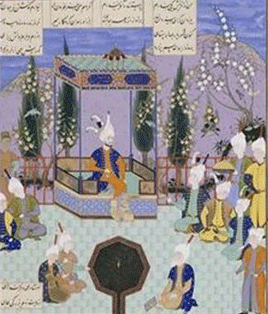
Looking for the perfect Christmas or Eid present? Well, if you have little spare cash but love rare books, why not mortgage the farm and go for one of the most beautiful illustrated manuscripts of all time, The Shahnameh of Shah Tahmasb Safavi in its Houghton manuscript form. This facsimile set of two volumes was edited by Martin Bernard Dickson and Stuart Cary Welch in 1981 and published by the Fogg Art Museum of Harvard University. And it is available for only $1495.00 plus shipping. Here are the details and it can be ordered by clicking here:
Description
Volume I: 312 pp., 22 eight-color plates, one plate ready to be framed, 284 black & white llustrations.
Volume II: 560 pp., 1 eight-color plate, 269 sepia plates.The Shahnameh (The Book of Kings), national epic of the Iranian people, was completed by the poet Ferdowsi in A.D. 1010. Its traditional 60,000 couplets outline exploits of Persian heroes, legendary as well as historical, before the Islamic conquest. A copy of Ferdowsi’s Shahnameh was an intrinsic part of a Persianate ruler’s library.
No surviving Shahnameh is grander in scale than that created in the early sixteenth century for Shah Tahmasb at Tabriz and purchased in the mid-twentieth century by, Arthur A. Houghton, Jr. Its 258 unusually large paintings and countless splendid illuminations make it the most sumptuous of all. Given the paucity of surviving buildings, textiles, and other examples of decorative arts of early Safavi culture, the book is a treasure trove virtually an art gallery revealing the evolution of Safavi painting in the crucial years between the early 1520s and the mid-1530s.Volume I describes the making of the Houghton Shahnameh. The styles, personalities, and careers of the many artists, led by the incomparable Sultan Muhammad, who participated in its making are analyzed, and the political history, colorful figures, and court intrigue of the period are described. This first major study of early Safavi painting contains an innovative discussion that links Safavi painting not only with the Timuri but also with the Turkman and other dynasties of Tabriz. Some 284 figures illustrate details of this Shahnameh and paintings from many sources, preceding and following, thus enabling the reader to draw comparisons with other miniatures and evaluate the importance of these. Full discussions of the other major manuscripts of the period, detailed notes, an extensive bibliography, two appendixes, and an index complete the scholarly apparatus.
The 269 plates of Volume II reproduce every one of the Houghton Shahnameh’s 258 miniatures in their actual size as well as the binding and many ornamental illuminations. These have been done in deep sepia, by collotype, a screenless process providing maximum integrity of detail, rarely used today because of its difficulty and expense. Each picture is faced by a text page that vividly describes the action taking place and gives full color details of the miniature. Horses prance, heads roll, courtiers preen, lovers embrace, dragons threaten, demons cavort, and history unfolds.
Twenty-two of these Shahnameh paintings are, in addition, reproduced in full color, also by collotype. A spectrum of colors, including burnished gold, faithfully reproduces the intricate beauty and detail of an incomparable manuscript. These color plates, which have tissue overlays, are tipped in and thus can be removed for separate mounting if desired.
Table of Contents
Both volumes of The Houghton Shahameh were set in English Monotype Bembo at The Press of A. Colish under the direction of Bert Clarke. Volume I was printed by offset by The Meriden Gravure Company, and the text imprinted directly from type by The Press of A. Colish. The sepia collotype plates in Volume II were printed by The Meriden Gravure Company and the text imprinted directly from by The Press of A. Colish. The color plates were printed collotype in eight colors plus genuine gold burnish by Jaffé Heliochrome.The paper for Volume I is Curtis Rag, manufactured by the Curtis Paper Company. The paper for Volume II is Caledonia Parchment, especially manufactured in England for this edition.
The books were bound by Tapley-Rutter Company, Inc.
The edition was designed by Joseph Blumenthol and Peter Oldenburg.
This was a limited edition of 750 copies published in 1981, 600 of which were made available to the public. Only a limited number of copies remain in stock today.